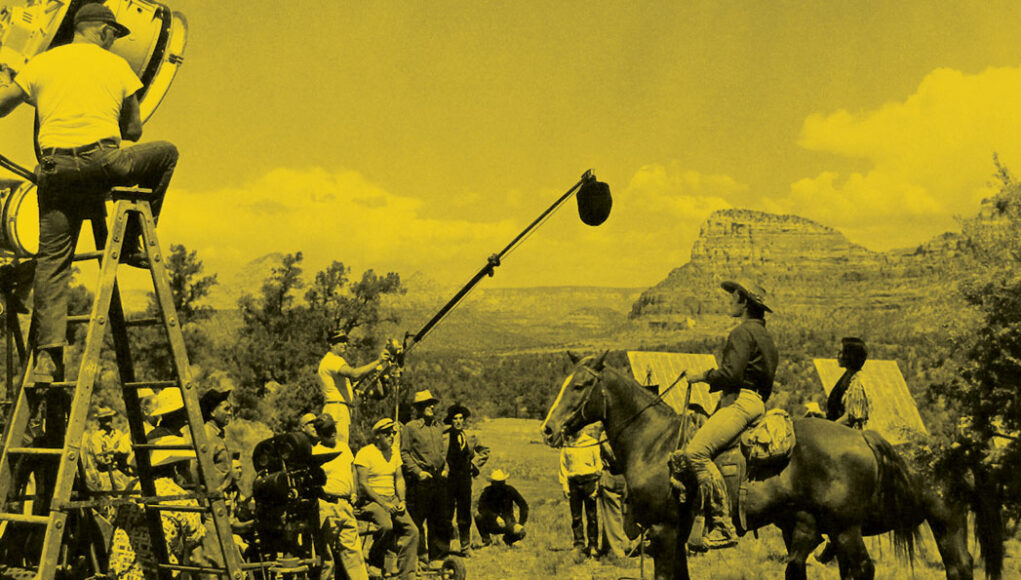Cheyenne star Clint Walker was big, handsome, and a key player in the development of TV westerns. This rugged mountain of a man, said to stand 6’6″, with a 48″ chest and a 32″ waist, played the titular character of TV’s first serious western drama, setting a template followed by shows like Gunsmoke and Bonanza. Walker’s film career never quite lived up to the promise of his 1956-62 Cheyenne run, with one exception — he’s unforgettable as the reluctant badass Samson Posey in The Dirty Dozen.
Life sometimes takes us in strange directions. For Clint Walker, life took the scenic route to show business. He began life as Norman Walker thousands of miles away from Hollywood. Nevertheless, the blue-eyed hunk ended his life as a cowboy Western staple, Clint “Cheyenne” Walker. In between those two distant points, Walker worked on cargo ships, riverboats, oil fields, and casinos.
He employed his considerable bulk shifting payloads or, as a bouncer, unwanted guests. His life took a radical turn for the better when actor Van Johnson suggested the gigantic looker try acting as opposed to security. Walker heeded Johnson’s advice figuring, “I’m not going to get that far carrying a gun and a badge. It doesn’t pay that well. If you make movies, you make some pretty good money — plus, the bullets aren’t real!”
Walker started in Hollywood as any other actor, taking small roles. First, he was Tarzan with a single memorable line. He recalled:
I come out of the jungle and I beat on my chest. I give the Tarzan yell and I say, ‘You no take Jane.’ These guys get together nose-to-nose and shake their heads. And then they say, ‘We no take Jane.’
He followed this nuanced portrayal with an appearance as a silent Sardinian guard in The Ten Commandments.
That’s where Walker really began to learn the ins and outs of Tinsel Town. “Here I was, just a beginner. But I’m working with Anne Baxter, Yul Brynner, Charlton Heston, Sir Cedric Hardwicke, Woody Strode — all these greats. And when I saw them make some mistakes, I thought, Woo! Maybe there’s hope for me. [Laughs.] I began to see what acting was really all about. I know Sir Cedric Hardwicke had a line in there somewhere and he meant to say “these halls” and he said “these balls”. Everybody had a heck of a laugh.”
Some actors toil away for a lifetime, never getting their break. For Walker, that break came early in the form of Cheyenne. Despite little experience, Walker owned a few advantages over the army of other actors eager for their shot.
I had real-world experience. I’d worked in security. I’d worked as a deputy sheriff. I’d carried a gun and a badge. And I felt right at home with it. That probably helped me some. I figured, Hey, I’m not going to get it, so why not just relax? Just relax and not worry about it. So that’s what I did. And then Jack Warner went through those two days of screen tests. And when they showed mine, he just said, ‘That is Cheyenne,’ and that was it. And like I said, he changed my name to Clint.
At this point, going from bouncer to western TV star ranked as an all-time achievement. However, Cheyenne took place during the western boom and competed with numerous other westerns to stay on the air. In fact, initially, Cheyenne was slated to share airtime with two other Westerns. They fell to the wayside and “Cheyenne” became a massive hit. Walker partially credited working for a big studio like Warner Bros for their success.
“I was blessed by being with Warner Bros., and them being willing to make it an hour-long program. I had a big advantage over the guys that were doing Gunsmoke [which was then a half-hour show] and some of the others. In a half-hour, you can’t develop your characters adequately.”
Walker also recalled that Warner Bros. “had some really good cutters. We couldn’t afford 1,000 cattle if we were doing a cattle drive. But they could go back to their big feature and a good [editor] could cut scenes of the cattle out of a film and put it in our Cheyenne.”
“Of course, once in a while, the cutters could really screw you up. I’d always try to have it so that there’d be one point where they’d pan over to me, and I’d be putting new bullets in my gun, so it would be more believable. Well, the doggone cutters would cut that scene out, and here I’d be shooting a six-shooter about 16 times without reloading. [Laughs.] Oh, those 16-shooters. Nothing like them.”
A major part of Cheyenne’s and Walker’s success came from his impressive physique. One reporter commented that “he has snow on his shoulders six months of the year.” His character also found convenient or completely inconvenient reasons for him to take his shirt off. For female and probably some male viewers, it worked like catnip.
When Walker first started Cheyenne, he told producers he had very little horse riding experience. They responded with “Well, don’t worry about it. After this first year, you’ll either be a good rider or a dead one.” [Laughs.] “There were a few times I wondere d which one I was going to be.”
PROC. BY MOVIES








